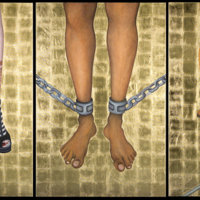
House Slave - Field Slave: A Portrait of Contemporary Slavery
'House Slave - Field Slave: A Portrait of Contemporary Slavery' was created in 2007 by Nicola Green in collaboration with Anti-Slavery International and first exhibited at Dulwich Picture Gallery. The artwork explored the concept of contemporary slavery and the stories of those still enslaved. The exhibition consisted of a large 'altarpiece' scale triptych set alongside artefacts of contemporary slavery from the International Slavery Museum and photos and text from Anti-Slavery International. It was later exhibited as part of Haringey's Black History Month at Bruce Castle Museum in 2010. The triptych is now in the permanent collection at the International Slavery Museum in Liverpool. Workshops were held at Dulwich Picture Gallery, The Prince’s Drawing Clubs, and International Slavery Museum in which students developed their skills in reading a work of art as a narrative, and responded by creating artworks that told their own personal story.
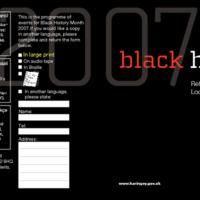
Haringey Council Black History Month
In consultation with the Black community in Haringey, the programme for Black History Month 2007 included many events to commemorate the bicentenary of the Abolition Act. Several took place at the Marcus Garvey Library in Tottenham, including poetry writing workshops, African drumming and dance workshops, and an exhibition and presentations led by Anti-Slavery International. There were several events to mark the bicentenary, including by Bedale House Supported Housing Scheme (featuring tenants' video diaries, a short film, poetry and guest speakers) and by Efiba Arts, supported by The Bridge New Deal for Communities. Haringey Council ran a poetry competition on the theme of slavery for young people aged 13-15. The winning entries were published in a pamphlet distributed to schools and libraries in the borough. Historian S. I. Martin led a guided tour of Haringey's places relating to the abolition of the slave trade. There was also a series of seminars by Robin Walker addressing 'Transatlantic Enslavement: What really happened?'.
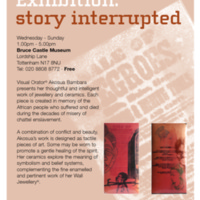
Story Interrupted
Story Interrupted was an exhibition of jewellery and ceramics by visual orator Akosua Bambara at Bruce Castle Museum. Each piece was created in memory of African people who suffered and died in enslavement.
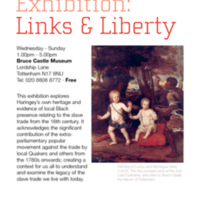
Links and Liberty
An exhibition at Bruce Castle Museum (in partnership with Euroart Studios) explored the transatlantic slave trade, Haringey's heritage relating to the trade and its legacy, and the historic Black presence in the borough from the 16th century onwards. There was a particular focus on the painting of Lucius and Montague Hare, sons of Lord Coleraine (former owner of Bruce Castle), with their African servant. The exhibition also looked at the extra-parliamentary popular movement against the trade by local Quakers such as Priscilla Wakefield and others. Contemporary dance workshops for secondary schools were led by dance company Movement Angol.
The Links and Liberty exhibition included 'Stolen', a life-size installation by artists at Euroart Studios (John Fowler, Lorraine Clarke and Nigel Young) of a section of a slave ship. School pupils were encouraged to climb inside to imagine conditions on board.
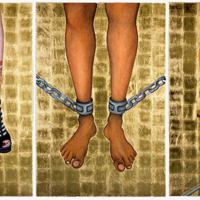
House Slave - Field Slave I and II
'House Slave - Field Slave: A Portrait of Contemporary Slavery' by Nicola Green was first exhibited at the Dulwich Picture Gallery in October 2007. It was then exhibited as part of Haringey's Black History Month at Bruce Castle Museum in October - December 2010. Nicola's triptych is now in the permanent collection at the International Slavery Museum in Liverpool.
Nicola Green's portrait of contemporary slavery 'House Slave - Field Slave' was made for and in collaboration with Anti-Slavery International to commemorate the anniversary of the abolition of the slave trade in 2007. The exhibition consists of a large 'altarpiece' scale triptych with preparatory studies. These are set alongside artefacts of contemporary slavery from the International Slavery Museum in Liverpool and the extraordinary photos and text from Anti-Slavery International, which inspired this work. The painting tells the story of contemporary slavery. There are an estimated 12 million people in the world today who are still enslaved - even though the British slave trade was abolished 200 years ago.